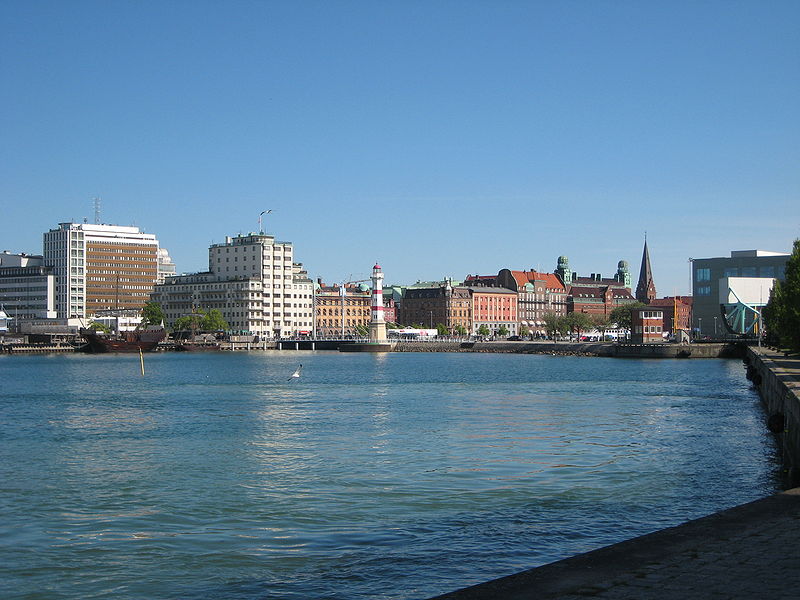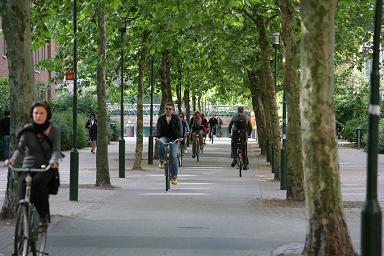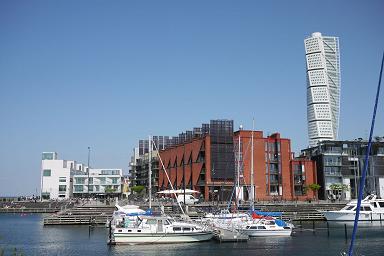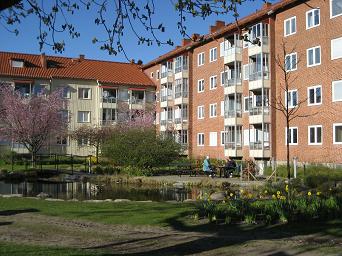Malmö – from industrial waste land to sustainable city
Over the last decades Malmö, in the southern part of Sweden, has made a remarkable journey from an industrial city based on its shipyard and other heavy industries to a modern entity founded on knowledge and sustainability.

The different stages in the Western Harbour have piloted different waste separation systems. While the first stage was equipped with vacuum systems, the later ones have waste grinders installed in all kitchens. The food waste is then gathered in storage tanks and transported for biogas production.
Bo01 was the first area to use a local green space factor to promote biodiversity, incorporating local vegetation, as well as rainwater through open storm water management and connection to the sea. The system was very successful; and since stage two, Flagghusen, the green space factor promoting ‘green’ roofs and walls (planted with vegetation) and biodiversity is included in the municipal Environmental Building Code.
The Western Harbour incorporates an eco-friendly transport system, with buses connecting the areas every five minutes. Bus stops feature real-time displays so passengers know when the next bus will arrive. Bicycle lanes are easily accessible and from the third stage, Fullriggaren, a new system has been developed to reduce the number of parking spaces and replace them with a car pool financed in the first years by the contractors.
The progress of development is continuing. The fourth stage, Kappseglaren, boasts among other things E.ON Smart Homes with a local smart grid. And the new areas Masthusen and Varvsstaden are being developed according to BREEAM Communities. The Western Harbour area will not be fully developed until the 2030s, with 20,000 citizens and a similar number of working places.
A Climate Contract
Malmö is putting a lot of effort into making the expansion areas of the city sustainable. In southern Malmö the Hyllie area, with 9,000 new homes and workplaces, will be the most climate progressive area in the region – according to the new Climate Contract, signed at the beginning of 2011 by the City of Malmö, the energy company E.ON and the municipal authority VA SYD.
"The energy supply in Hyllie will be entirely from renewable or recycled sources by 2020"
The energy supply in Hyllie will be entirely from renewable or recycled sources by 2020. But for that to be conceivable there is a need for constructors also to be involved in the process. A very successful strategy that was first implemented in the Western Harbour area was the construction dialogue between the city and the construction companies. The tools of Construction Dialogues and the Environmental Building Code are used to reach a common understanding and road map for the building process in Hyllie.
Refurbishing into sustainable form
The city has also focused on transforming existing areas for more sustainability. One of the most striking examples of this is the Augustenborg district, where the city, together with the local housing, water and sewage company, has refurbished the area in close cooperation with the citizens into a more sustainable form. The project was launched in 1998 and the results so far indicate that Augustenborg has become an attractive, multicultural neighbourhood in which the turnover of tenancies has fallen by almost 20 per cent and the environmental impact has decreased to a similar degree.
Many of the houses in the area were run down, and the 1950s character of some of the buildings was damaged in the 1970s by covering the facades with external insulation and steel sheeting. This also had a negative effect on the internal environment in certain houses causing problems with damp, ventilation and temperature control.
To reclaim the look of the houses and improve energy efficiency and housing condition, the outer covering of the walls on some of the buildings has been removed and a new insulation layer has been covered with a skin of painted rendering. The appearance of the houses is now more like the original, and the energy efficiency has increased by about 10 per cent compared with the 1998 state of the buildings, or perhaps 35 per cent more than the original buildings.
Involving the residents of Augustenborg has been one of the crucial success factors of the refurbishment. Residents, pupils and people working in the area were engaged in the design of the outdoor environment, to create a new habitat while increasing the amenity value. Flowering perennials, native trees, fruit trees and wetlands are key features, while bat and bird boxes provide additional accommodation on the housing estate. Today, 15 years later, all the 30 gardens in Augustenborg have been renewed within the project.
One of the main problems highlighted by the residents in Augustenborg was the reccurring flooding of basements and parking lots during heavy rain. The storm water system has gone through a major change since then: green roofs and open storm water channels leading into ponds have diverted the flooding in the area, and have created a beautiful environment and a richer biodiversity. The houses have 2,100 sq metres of green roofs, as well as the large facility at the Botanical Roof Garden, which covers 9,000 sq metres.
There are today a total of 6 km of canals and water channels in Augustenborg. Ninety per cent of the storm water from roofs and hard surfaces is led into the open storm water system in the housing area.
"The results of the Augustenborg project are astonishing; energy consumption has decreased, basement flooding has been prevented"
Waste management and recycling has also been addressed in the area. Today there are 15 facilities with full recycling and composting for the 1,800 inhabitants of Augustenborg. The aim is that 90 per cent of the waste will be collected and recycled or re-used in some way. So far this figure has reached about 70 per cent. The houses were based on design ideas from some of the residents who had been involved in the initial recycling pilot and who visited recycling programmes in other Swedish cities.
The results of the Augustenborg project are astonishing; energy consumption has decreased, basement flooding has been prevented, and perhaps most important of all, the inhabitants are once again proud of living in the Augustenborg area.
Applying the experience
Since we know that one of the largest challenges for the coming years is to refurbish the existing housing stock both in Malmö and the rest of Europe, the experiences from Augustenborg are invaluable. The City of Malmö has already started the implementation of some of the good examples in city districts such as Rosengård and Lindängen. In Rosengård the City of Malmö is developing new methods for dialogue with the inhabitants; the ecological refurbishment is alsocreating the bicycle and pedestrian infrastructure to connect the area with the city centre.
The housing cooperative HSB Brf Hilda in Rosengård is implementing a unique renovation programme with very high sustainability targets for its 767 apartments. One of these targets is to reduce carbon dioxide emissions by replacing the ventilation system and installing photovoltaics on the roofs. Climate coaches inspire residents to a sustainable lifestyle, and new technology is combined with proven technology to achieve economic sustainability.
The bicycle city

We even try to prioritise bicycles in our city. At 28 intersections in Malmö, a sensor system has been installed to grant cyclists priority. As cyclists approach an intersection that is not already crowded by car traffic, the lights quickly turn green to favour the cyclist.
Some of the journeys in Malmö will still require a car – but also these should be done sustainably. Malmö is now introducing mandatory food waste collection, to be turned into biogas. The biogas can power buses and cars in the city and already today all 177 city buses in Malmö run on a mix of compressed natural gas and biogas. The number of passenger cars driven on biogas is also increasing, and the City of Malmö municipal vehicle fleet will run entirely on biogas, electricity and hydrogen by 2015.
Ambitious targets
Since 2009 the City of Malmö has set itself one of the most ambitious climate targets in the world: by 2020, the city administration will be climate neutral; and by 2030 the whole city will run on 100 per cent renewable energy.
To reach these targets we need to work on all aspects of energy consumption. As well as transport, the heat delivered to our citizens in the district heating grid will have to be supplied with renewable resources. The electricity in the grid will also be produced renewably; and already today the Lillgrund wind farm, in the Öresund strait just outside Malmö, produces enough electricity for 60,000 households. The wind conditions in Malmö are extremely good and we believe that an expansion of wind power will be not only necessary but also beneficial for the city.
"The Lillgrund wind farm, in the Öresund strait just outside Malmö, produces enough electricity for 60,000 households"
We know that our efforts to become a sustainable city are inspiring others, and we are very proud of what we have already achieved – although we have a long journey in front of us. The targets and progress on climate issues in Malmö have been also been acknowledged by other organisations, such as WWF Sweden, who appointed Malmö as the “Earth Hour Capital of Sweden 2011”, and UN Habitat, who awarded the city the Scroll of Honour Award in 2010.
The city of Malmö has taken a holistic attitude to sustainability. Political ambition and leadership is strong, with goals set at a high level. The city departments cooperate with each other and with enterprises, universities and organisations. The aim is to use ecological development as a driving force for economic growth and social innovation – a challenge that includes and demands commitment from all actors in society. Using different cooperation methods and processes is therefore one important key to the achievement of these high targets. To develop a sustainable city is a team task; all actors taking responsibility for this are winners.










